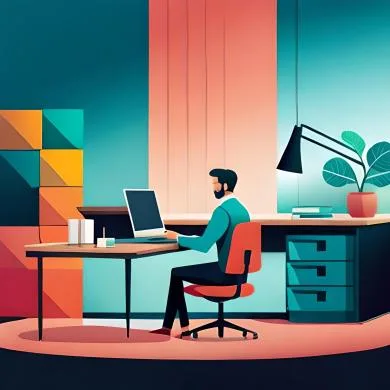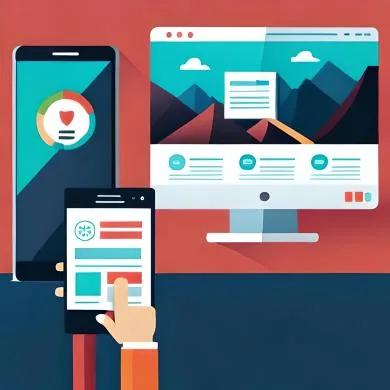Introduction
Web design is a multifaceted field that holds immense significance in the digital age. It encompasses the art and science of creating visually appealing, functional, and user-friendly websites. At the core of this process lies inspiration, a powerful force that shapes the direction and outcome of web design ideas.
The Spark of Creativity
Unearthing the sources of inspiration
Web designers draw inspiration from a myriad of sources, each contributing to the enigmatic voyage of web design ideas. Nature, with its captivating beauty and harmony, often serves as a wellspring of creativity. The organic forms, colors, and patterns observed in nature can be seamlessly translated into web design elements, imbuing websites with a sense of tranquility and authenticity.

Art and design movements also act as catalysts for web design inspiration. By studying the works of renowned artists throughout history, web designers can glean insights into visual composition, color palettes, and aesthetic principles. The boldness of the Cubist movement or the elegance of Art Nouveau can inspire innovative approaches to web layouts.
Architectural design offers yet another realm of inspiration. The structural elements, such as lines, shapes, and proportions, found in architectural marvels can be translated into web layouts, creating visually engaging and well-organized interfaces.
Cognitive processes behind generating ideas
The generation of web design ideas involves complex cognitive processes that allow designers to expand their creative possibilities and refine their concepts. Divergent thinking, characterized by an open and free-flowing exploration of ideas and possibilities, allows designers to break away from conventional boundaries and explore innovative design solutions.
Convergent thinking comes into play when designers focus and refine their ideas. This process involves evaluating and selecting the most promising concepts, eliminating unnecessary elements, and optimizing the design for usability and functionality. Striking the delicate balance between creativity and usability is paramount, ensuring that web designs not only captivate but also provide intuitive navigation and seamless user experiences.
Translating Inspiration into Design
Sketching and wireframing
Sketching serves as a preliminary design tool, allowing designers to translate their raw ideas onto paper. It provides an opportunity to explore different layouts, experiment with composition, and quickly iterate on design concepts. Through sketches, designers can visualize the overall structure and spatial relationships within a website.

Wireframing, on the other hand, involves building the structural framework of a web design. It provides a detailed blueprint that showcases the layout, content hierarchy, and navigation flow of a website. By wireframing, designers ensure that the design aligns with both user expectations and functional requirements.
Choosing colors, typography, and imagery
The choices of colors, typography, and imagery greatly influence the overall visual impact and message conveyed by a web design. The psychology of colors plays a vital role in web design, as different colors evoke different emotions and associations. Designers must carefully select color palettes that resonate with the intended message, fostering a harmonious and aesthetically pleasing experience for users.

Typography plays a crucial role in communicating the essence of a website. The choice of typefaces, font sizes, and spacing greatly impacts readability and the overall tone of the design. It is vital to select typography that aligns with the brand identity and complements the overall visual hierarchy.
Imagery adds depth and context to web design, evoking emotions and capturing the attention of users. By carefully selecting and incorporating relevant imagery, designers can enhance the overall user experience and create a cohesive narrative.
Responsive design and user experience (UX)
Web design must adapt to the ever-expanding range of devices and screen sizes. Responsive design ensures that websites seamlessly adjust their layout and content to provide optimal viewing experiences across various devices. By prioritizing a mobile-first approach, designers can guarantee a seamless user experience, regardless of the device used.

Enhancing the user experience extends beyond responsive design. Intuitive navigation, logical information architecture, and thoughtfully curated content all contribute to ensuring that users can effortlessly explore and engage with a website. By prioritizing user experience, designers can create web designs that are both aesthetically pleasing and user-friendly.
The Roadblocks and Challenges
Creative blocks and overcoming them
Design stagnation is an inevitable challenge faced by web designers. When inspiration wanes, creativity can suffer, leading to a block. To overcome this, designers can explore new avenues for inspiration, such as attending design conferences or seeking input from fellow designers. Taking breaks, engaging in creative hobbies, or experimenting with different design techniques can also reignite the spark of inspiration.

Copyright and plagiarism concerns
Respecting intellectual property rights is crucial in the ever-evolving digital landscape. Designers must be aware of copyright laws and ensure that their work is original and does not infringe upon the rights of others. Ethical practices, such as properly attributing sources and seeking permissions when necessary, help prevent plagiarism and foster a culture of creativity and respect.
Balancing innovation and conformity to trends
In web design, trends come and go, and designers must strike a delicate balance between embracing innovation and meeting user expectations. Evolving design trends can serve as sources of inspiration, but blindly following them can lead to conformity and a lack of originality. Striving for a fresh perspective while considering user preferences is vital to creating unique and engaging web designs.
The Lifespan of Web Design Ideas
Launching a design into the vast digital landscape
After the creative process, it’s time to deploy and host a website. Choosing the appropriate hosting options ensures that the design is accessible and functional for users. Additionally, optimizing the website for search engine visibility through search engine optimization (SEO) techniques increases its chances of being discovered by the target audience.
The ephemerality of web design trends
Design trends have a finite lifespan, and web designers must evaluate the longevity of popular design elements. Evaluating the relevance and effectiveness of design trends helps determine their viability in creating user-centric designs. Navigating the cyclical nature of web design trends requires the ability to adapt and remain innovative in an ever-changing digital landscape.

Fading into Oblivion
The inevitability of design obsolescence
Technological advancements continuously shape the path of web design. New frameworks, coding languages, and tools emerge, rendering older design practices obsolete. To stay relevant, designers must keep abreast of technological advancements, embrace new methodologies, and adopt responsive design practices.
Legacy websites, while once groundbreaking, eventually fall behind in terms of functionality and user expectations. As the need for modernization becomes apparent, phasing out legacy websites becomes a necessity for ensuring optimal user experiences.
The nostalgia and revival of old web design ideas
Amid the perpetual progression of design practices, there is a nostalgia for past web design aesthetics. Retro web design resurfaces as designers embrace the charm and familiarity of earlier eras. By incorporating retro elements into contemporary designs, designers can strike a delicate balance between nostalgia and usability, creating unique and engaging experiences.

Conclusion
The journey from inspiration to oblivion in web design is a cyclical process of creation, obsolescence, and revival. Web designers continuously draw inspiration from various sources, creatively transform ideas into designs, and adapt to the ever-changing digital landscape. Embracing the perpetual cycle of web design evolution allows designers to create compelling, user-centric experiences that transcend time and trends.
FAQs
How can I overcome designer’s block during the creative process?
Designer’s block can be overcome by exploring new sources of inspiration, seeking input from others, taking breaks, and experimenting with different design techniques.
What steps can I take to protect my original web design work?
To protect original web design work, it is essential to be knowledgeable about intellectual property rights and to ensure that designs do not infringe upon the rights of others. Properly attributing sources and seeking permissions when necessary helps prevent plagiarism and fosters a culture of creativity and respect.
Is it necessary to always follow design trends, or can I create something unique?
While design trends can serve as sources of inspiration, blindly following them can lead to conformity and a lack of originality. Designers should strive for a fresh perspective while considering user preferences and creating unique and engaging web designs.
How do I ensure my web design remains relevant as technology advances?
To ensure web design remains relevant, designers must keep abreast of technological advancements, embrace new methodologies, and adopt responsive design practices. Regular updates and staying informed about evolving user expectations and needs also contribute to the long-term relevance of a web design.
What are some strategies for updating and reviving an outdated design in a nostalgic way?
When updating and reviving an outdated design in a nostalgic way, designers can incorporate retro elements, such as color palettes or typography, while ensuring that the design remains functional, user-friendly, and aligned with contemporary standards. Striking a balance between nostalgia and usability is crucial for creating engaging and memorable web experiences.


